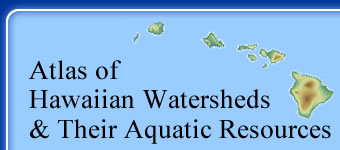
Key to Methods - General Introduction
The production of the Atlas of Hawaiian Watersheds & Their Aquatic Resources was a large undertaking, and the information displayed in this Atlas reflects the data stored in the DAR Aquatic Surveys Database, as well as information from different GIS datasets developed by various parties concerning land or stream characteristics observed in Hawaii. The DAR Aquatic Surveys Database is hierarchically designed with observations of animals occurring within a site, sites occurring in a stream segments, stream segments in a stream, streams in a watershed, watersheds within a region, regions within an island, and islands within an island chain (Kuamo'o, Higashi, & Parham, 2007). As a result, the Atlas is a summary of the information at the watershed level. Data collected at the observation site, stream segment, and at stream levels are grouped to provide an accounting of the information for each watershed.
In the development effort for the DAR Aquatic Surveys Database, new boundaries for watersheds in the state were determined and each watershed was coded with a unique number. To accurately determine watershed boundaries for the state, GIS techniques were used that predict the direction of runoff for each cell in a digital elevation model. Digital elevations models developed by the US Geological Survey with a resolution of 10m for Hawai'i were used. The process resulted in well over 1000 large watersheds of which approximately 400 contained some type of perennial or intermittent stream channel. Watersheds selected for inclusion in this Atlas were those that contained at least one biological survey or, in the absence of survey information, are those watersheds with streams longer than 1 km.
The watersheds for each island are arranged by regions and listed individually with a numerical watershed code.